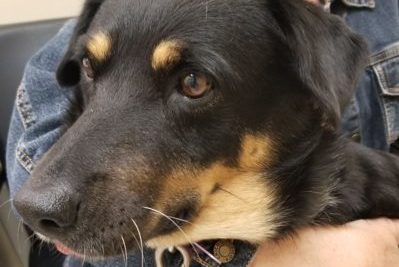Canine Transmissible Venereal Tumor (CTVT): a 6000-year-old Tumor

Canine Transmissible Venereal Tumor (CTVT): a 6000-year-old Tumor
November is National Pet Cancer Awareness Month, so today’s blog will focus on a fascinating tumor of dogs, the canine transmissible venereal tumor (CTVT). I say fascinating because this tumor is contagious and spreads from dog to dog during mating. This strange tumor is also curable with chemotherapy.
Jeter, shown above, is a recue dog currently fostered through Ruff House Rescue until he finds a forever home. Placement into a new home has been delayed by a diagnosis of CTVT. Oncologists at AMC’s Cancer Institute expect Jeter to make a full recovery following treatment with weekly vincristine chemotherapy. Jeter’s treatment paid for by the AMC to the Rescue fund, which subsidizes specialty care to animals currently cared for by rescue groups, whose health has become an obstacle to their adoption.
6000-year-old Tumor
Based on genome analysis of hundreds of CTVTs worldwide, this tumor most likely arose from a normal dog cell about 6000 years ago. The genetic analysis leads researchers to conclude the founder dog came from Asia and as dogs migrated with humans, CTVT migrated with them. Over the millennia, the genetic diversity of CTVT remained quite stable and the tumor is genetically very similar in all geographic locations studied.
Transmissible Venereal Tumor
Transmissible venereal tumor is a unique tumor. Cancer typically arises from the cells of the person or animal afflicted with the tumor. Cells in a CTVT are those of the founder dog who first had this tumor thousands of years ago. Most of us know cancer is not contagious, but “horizontal transmission” between members of the same species does occur in two animal cancers: CTVT and the Tasmanian devil facial tumor.
Another unique feature of CTVT is its ability to evade the immune system. CTVT is essentially a tissue transplant from an unrelated dog. Normally, the immune system would reject tissue from an unrelated dog, similar to what happens in an organ transplant. However, CTVT lacks cell surface structure that trigger the rejection response. Mating of a CTVT affected dog transplants tumor cells to an unaffected dog and the tumor cells grow unchecked by the immune system.
AMC to the Rescue
Jeter is the second dog with CTVT accepted into the AMC to the Rescue Program. Both dogs with CTVT came from Texas where CTVT is more common than in New York City. The first dog, Melinda, was a female dog with a vulvar TVT. She responded well to treatment and now has a forever home with two delighted little girls and their parents. Jeter is a very mellow dog and we hope he will be as fortunate as Melinda was in finding a forever home. Jeter and Melinda are just two of over 350 lucky patients accepted into the program since its creation in 2013.






























